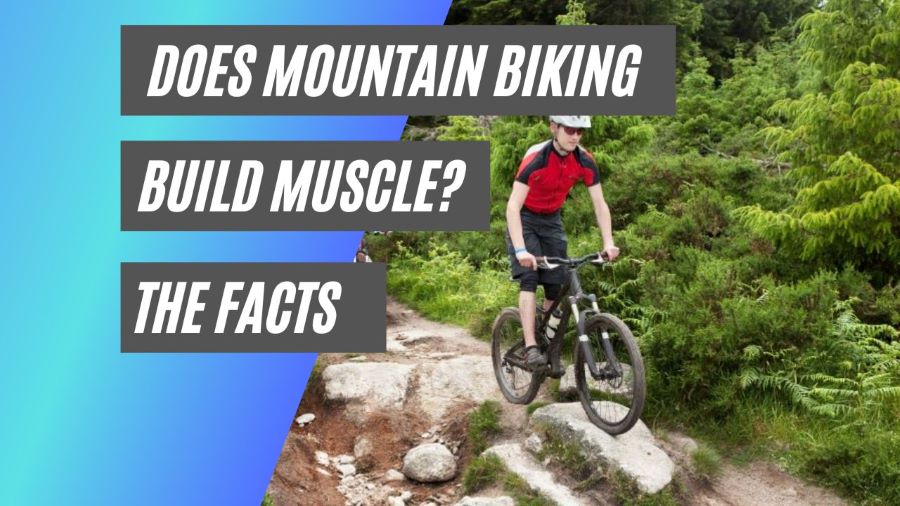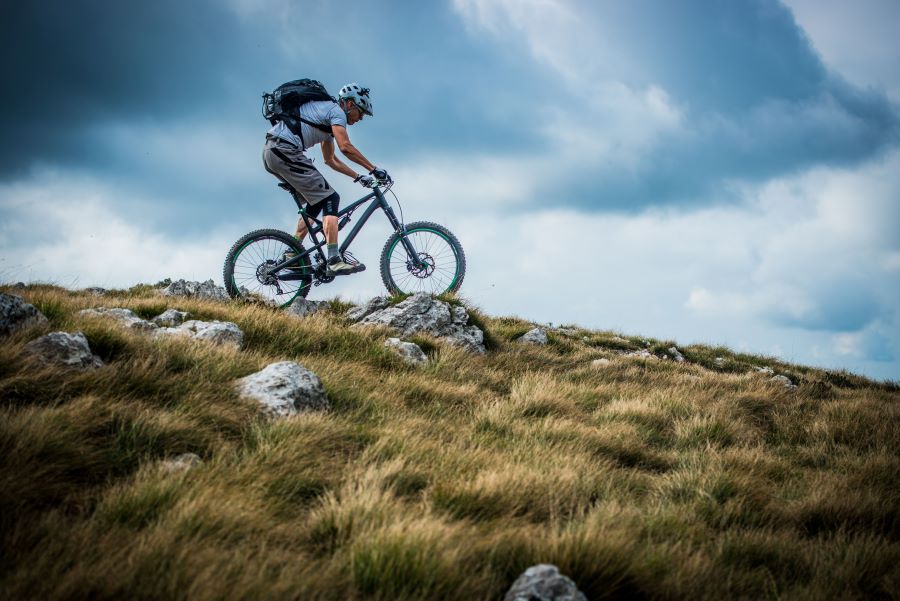This post may contain affiliate links. If you click an affiliate link and make a purchase, I may earn a commission. Also, as an Amazon Associate, I earn from qualifying purchases.--
If you’ve seen pro-mountain bikers in action, you’ll see that they’re really sinewy and muscular in a lean way. And when you go mountain biking, you have to keep control through all sorts of jolts and jerks. Does that mean that mountain biking builds muscle?
Mountain biking helps develop some muscle in the lower body, particularly the quads, and glutes. It will also help to tone calves, hamstrings, core muscles, and arms to an extent. Mountain biking tones and sculpts, and will add some level of extra muscle mass.
In this post, I’ll look at:
- Mountain biking vs road biking for building muscle
- Mountain biking – which muscles are working
- Factors that affect the amount of muscle developed through mountain biking
- 11 facts about mountain biking and muscle development

Mountain Biking vs. Road Biking For Building Muscle
There’s much debate about which is better in general – mountain biking or road biking.
The first primary difference between mountain and road cycling is the bike. Manufacturers designed road bikes for speed, while they made mountain bikes for utility and stability.
But the most relevant difference point of difference is the muscle work involved in both types of biking.
In road biking, the most targeted muscle regions are in your legs and hips. On the other hand, mountain biking involves virtually every major muscle group in your body.
Here’s a table outlining the key differences between mountain and road biking:
| Point of Comparison | Mountain Biking | Road Biking |
| Anaerobic | Yes | No |
| Aerobic | Yes | Yes |
| Lower Body | Yes | Yes |
| Upper Body | Yes | No |
Mountain Biking: Which Muscles Are Working?
Because of the nature of the sport, you’ll find that mountain biking does work every muscle in your body. It is considered an extreme sport because of exactly this.
When pedaling through difficult terrains, you use your upper and lower torso to steer, navigate, and control your bike.
Upper-Body Muscles
It might surprise you, but mountain biking uses several of your upper-body muscles. Your chest, shoulders, arms, forearms, and even your back are all in use.
The biceps are at work when moving and stabilizing your handlebars. You use your forearm muscles for gripping the handle, shifting the gears, and braking.
The most challenging part of this sport is the stress and vibrations from the rough terrain—especially when descending. Your triceps and pectoral muscles help keep you stable despite those.
Lower-Body Muscles
Of course, as an exercise that utilizes a bike, your leg muscles are the primary working muscles when mountain biking. Specifically, you’re using your glutes, hamstrings, quadriceps, and calf muscles.
You can locate your hamstring muscles sitting below your buttocks opposite the knees. They enable you to pull your leg up to prepare for that push-down on the pedal to move you forward.
As you push down on the pedal, your body weight shifts onto your quadriceps and calf muscles. You’ll find your quadriceps on your upper legs and your calf muscles behind your lower legs.
Finally, your glute muscles are also working when pedaling. Your glutes support your thigh movements and improve the balance around your abdominal muscles.

What Muscles Does Mountain Biking Build?
As a full-body workout, mountain biking does help tone and build several muscle groups in your body.
The main muscles you’ll develop will be your quadriceps, glutes, and calf muscles.
Aside from those, your biceps, triceps, and forearm muscles will be in a constant workout. So it won’t be a surprise if they turn out more toned and buff after a few months of mountain biking.
If you want to work out your core muscles, then the rough terrain will take care of that for you. The more difficult the way, the more you’ll be relying on your core muscles.
With that in mind, you can expect that the muscles around your abdomen, lower back, and pelvic area will become more defined over time.
Any high-impact workout that includes large physical movements puts a lot of stress on your body. Sprinting, running, and sports can take a heavy toll on your joints and muscles over time.
It’s where mountain biking truly shines because you have control over the intensity of your workout. You can pick the difficulty of trails according to your skill level.
That said, you can tone and build your muscles with minimal joint stress. Plus, who doesn’t love the idea of exercising while exploring and enjoying nature?
Factors That Affect Muscle Building When Mountain Biking
If you want to optimize the muscle-building effects of mountain biking, you should learn the factors that contribute.
1. The Terrain
Rocky and hilly terrains will make for a tougher muscle workout. The strength and coordination you’ll need to control the trajectory of your bike will increase along with the terrain’s difficulty.
2. The Bike
Apart from the terrain, the bike also plays a crucial role in your muscle building.
The heavier the bike, the more you use your upper body muscles to steer it.
3. The Effort
Finally, the effort you put forth can significantly increase or decrease the outcome of your workout.
The more work you put into your muscles, the more they develop and improve! (Not really rocket-science, but there you go)
I found a fantastic Youtube video about the best way to build muscle, and terrain is discussed in this, alongside other issues. You can watch the video here:
Mountain Biking: 11 Muscle And Fitness Facts
Many studies reveal there are many health benefits to regular biking. These are things that really funnel into building and toning muscle
When your body is operating in a healthy way, the more likely you are to build muscle.
Here are 11 health and fitness benefits you’ll get when cycling, all of which link to building muscle to some degree:
1. Heart
Your heart is one of the primary benefactors when you regularly ride a bike.
As an aerobic exercise, mountain biking improves your heart’s muscles.
In addition, regular cycling helps manage cholesterol and fat level in your blood vessels. This leads to a lower risk of hypertension and high blood pressure.
2. Lungs
Aside from your heart, the cyclical and rhythmic nature of biking does wonders for your lungs as well.
As you cycle, your lungs and diaphragm work harder to send oxygen through your muscles.
This helps to increase your lungs’ capacity to distribute oxygen efficiently. Pedal consistently, and you’ll find yourself breathing easily and deeply.
3. Brain
If you’re new to mountain biking, you’ll be surprised to know that it helps ease stress, depression, and anxiety. It allows you to focus and concentrate on the present.
On top of that, research published in 2019 proved that cycling positively affects the brain’s cognitive function. So, if you’re ever feeling down and listless, you better get on that bike!
Reducing stress is an excellent foundation for building muscle, as you will sleep for longer (when muscle growth takes place), and you’re blood-flow and cell production will be maximized.
4. Reflexes
Mountain biking requires focus and attention. While riding, you need to react quickly to sudden turns, twists, and evasive maneuvers.
5. Calories
If you’re experiencing weight problems, mountain biking is a great option to lose a significant amount of calories.
Continuous cycling can burn around 200 to 1400 calories per hour.
Add biking to your weight management program, and you’ll lose that extra weight in no time! Stick to a schedule and pair it with a healthy diet to get the best results.
6. Immune System
Perhaps one of the great benefits of consistent exercise is it enhances your immune system. Your body’s ability to fight infections from bacteria and pathogens will considerably increase.
Activities that increase your blood flow and promote the performance of your immune cells and antibodies. Ride a bike and prevent sickness and diseases!
7. Coordination
Mountain biking requires your body and mind to work together. Your arms to steer and navigate, your legs to pedal, and your body for balancing.
All parts of your body must coordinate as you go through the trail. Take your mind off the road, and you might tumble through a bush!
8. Joints
High-impact exercises, like running and weight training, burn calories and refine your body’s muscles. However, they put too much stress on your joints, especially the knees.
On the other hand, biking works your muscles without putting a lot of strain on your joints. Because of this, it strengthens the tendons and ligaments around your leg muscles.
9. Balance
As we mentioned before, riding tones your legs, core, and gluteus muscles. These components are vital in balancing your body as you walk and run.
A study in 2014 discovered that constant cycling improves gait and balance. After the study, the participants gained better control over their bodies while doing large-movement tasks.
10. Sleep
If you’re having sleeping problems, then you should really start pedaling.
Biking will decrease your brain’s cortisol, the hormone that keeps your body awake.
In addition, studies have shown that regular cycling helps synchronize your circadian rhythm. It also reduces your stress hormones and promotes regenerative sleep.
11. Stamina
Riding is exceptionally effective in boosting your stamina. It allows your cardiovascular muscles to endure prolonged periods of working without fatigue.
In fact, experts found that cycling is better than running when it comes to improving your endurance. So, you shouldn’t have any problem increasing your mileage every day!
Final Thoughts
Mountain biking has been rising in popularity in recent years. In the US alone, around 8 million people participate in the thrills of pedaling over mountains and terrains. (Source)
But does mountain biking build muscle?
It does and more! It helps improve your cardiovascular health, weight management, immune system, and cognitive functions, all of which can feed back into muscle development and keeping you feeling healthy.
